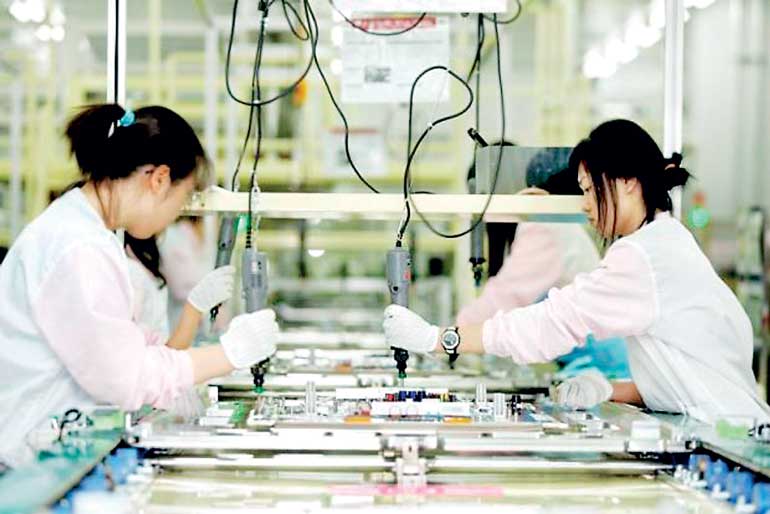Friday Jan 09, 2026
Friday Jan 09, 2026
Wednesday, 9 September 2015 00:00 - - {{hitsCtrl.values.hits}}
 The assembly line at the LG factory in Gumi, Republic of Korea. There is a strong case to take advantage of Sri Lanka’s current 360 degree foreign policy to deepen economic engagement with the Republic of Korea across a number of areas
The assembly line at the LG factory in Gumi, Republic of Korea. There is a strong case to take advantage of Sri Lanka’s current 360 degree foreign policy to deepen economic engagement with the Republic of Korea across a number of areas
The Republic of Korea (R OK)’s development record is arguably the most impressive since the end of the Second World War. The country experienced harsh Japanese rule and subsequently the Korean War (1950-53) which resulted in the partition of the peninsula.
OK)’s development record is arguably the most impressive since the end of the Second World War. The country experienced harsh Japanese rule and subsequently the Korean War (1950-53) which resulted in the partition of the peninsula.
ROK has, therefore, had to come through periods of conflict involving each of its two larger neighbours: Japan and China during the last 100 years. Despite this, thriving economic relations with its two neighbours have been a major part of ROK’s success over the last five decades; as has been the US defence umbrella and economic support.
ROK’s per capita GDP increased from $105 in 1965 to $27,970 in 2014. During the same period, the equivalent figures for Sri Lanka were $152 and $3,631. ROK also topped the global ranking on education outcomes in 2014. 
Sri Lanka/ROK trade has increased from $368 million (2013) to $408 million (2014). ROK is also an important source of foreign employment for Sri Lankans, particularly for male unskilled and semi-skilled workers.
There was also a time when ROK accounted for the highest share of FDI in to Sri Lanka. It is noteworthy that during the conflict, when investors from other countries were risk averse, the Koreans were more robust in their attitude to investment in this country.
There is a strong case to take advantage of Sri Lanka’s current 360 degree foreign policy to deepen economic engagement with ROK across a number of areas.
nAttach priority to reviving ROK investment, which does not carry the historical baggage or strategic complexities of investment from China, India or the West. This would be particularly timely at this time. Last year, China was ROK’s largest trading partner ($290 billion or about four times Sri Lanka’s total GDP). With the anticipated slower trajectory of Chinese growth, ROK is seeking to diversify its economic relations. Priority should be attached to conducting a comprehensive study to explore ways of increasing investment and technology links between Sri Lanka and ROK.
nThe combination of ROK’s diversification strategy, and the forecast that India will be the fastest growing large economy, is likely to create potential opportunities for plugging into supply chains of ROK companies operating in South Asia, particularly in India.
nThere could also be scope to promote collaborative investment involving Korean know-how and a third country’s capital. The industrial zones being proposed by the new government provide a framework for attracting such investment. This would serve to leverage the respective strengths of the two economies, while defusing concerns regarding any third country’s growing presence in the Sri Lankan economy.
nAs ROK expands its presence in this sub-region as part of its diversification strategy, Sri Lanka should aggressively seek to attract the regional offices of Korean companies coming into the region or expanding their existing activities. This country offers a quality of life, which is the best in South Asia for Korean expatriates. Communications and connectivity are also well advanced.
nThere are a large number of outbound tourists among ROK’s wealthy middle class. Priority should be given to promoting Sri Lanka as a tourist destination.
nROK has a Knowledge Sharing Program (KSP), whereby it shares lessons learnt from the ‘Korean Miracle’. Sri Lanka can benefit from gaining a greater understanding of the evolution of ROK’s successful economic strategy, policies and programs. Contacts between policy-makers, academics, businesses, etc. of the two countries should be increased.
nROK is also ranked among the most advanced countries for learning outcomes. Hence, education is another area where knowledge-sharing can add value.
ROK has been a trusted and durable friend of Sri Lanka. There is much that can be learnt from the ‘Korean Miracle’. It does not see itself as a global or regional power. Nor does it have a legacy as a coloniser. This means ROK has no special agenda. Instead, it has considerable knowledge about development, with demonstrably successful outcomes, which it is keen to share. It also has world-class companies with capital, access to markets, technology and know-how. It also has a large middle class market with considerable purchasing power. There is, therefore, every reason for Sri Lanka to look for ways and means of expanding its bilateral economic ties with ROK.
(This is the 75th Economic Alert of Pathfinder Foundation. Readers’ comments are welcome at www.pathfinderfoundation.org.)